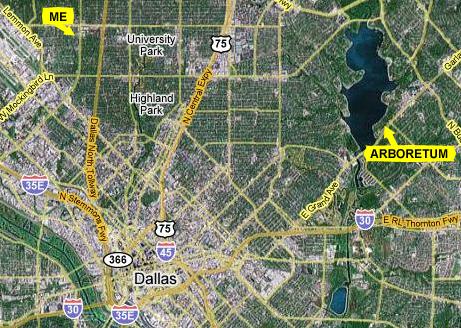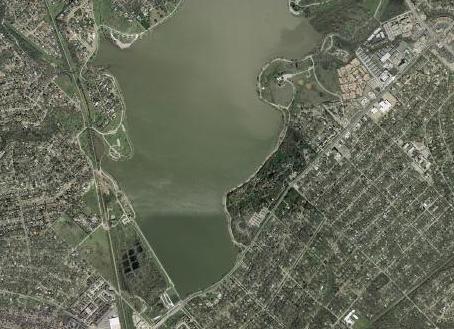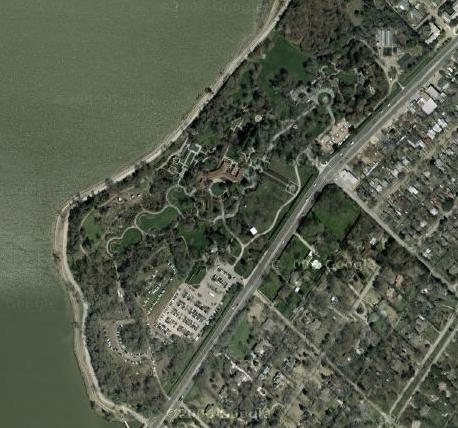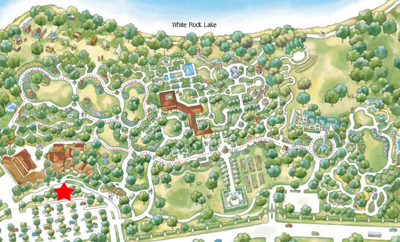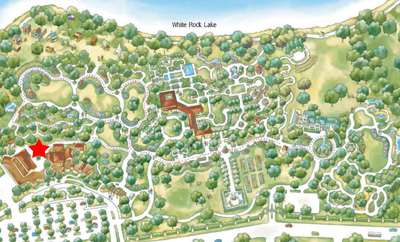 |
October 1, 2012: Chihuly at Night |
 |
September 18, 2012: Summer's End at Downhill Run Acres |
 |
Return to the Index for 2012 |
September 27, 2012
We Take Prudence and Nancy to See the
Chihuly Exhibit at the Dallas Arboretum
Prudence has come to Dallas to visit her sister for a few days, and while she is here, we are taking her and her sister, Nancy, to the Arboretum to see the exhibit of Chihuly glass sculptures. Fred and I have been here twice, already. The first time was with Rudolf back in July and the second time was with Guy just a few weeks ago. Necessarily, this album page will be repetitive insofar as the pictures of the exhibit are concerned. If you have not already done so, and would like to visit an album page that concentrates on the exhibit itself (rather than who happened to be with us), the best page to visit would be
the page for August 22nd when we took Rudolf. It was our first visit, we saw every piece on exhibit, and I included a good bit of narrative about each piece.
This page will be laid out the same way and, while it will include some of that narrative, we did not stop to see each and every piece on exhibit. You are welcome to peruse this page, but I just don't want you to get bored thinking "Haven't I seen this/read this before?" Of course, the one thing this page will have that the other's don't are the pictures that include Nancy or Prudence or both (and I will try to concentrate on those pictures).
With those caveats, let's head off to the Arboretum!
Getting to the Dallas Arboretum
The Dallas Arboretum is not too far from where I live over on Inwood- I'd guess about six or seven miles as the crow flies (see the map opposite)- but you can't get there as the crow flies because White Rock Lake is in the way. So you can either go through town and wind your way around the south end of the lake or you can take Mockingbird over around the north side of the lake. Today, we just took Mockingbird over to Buckner Boulevard to Garland Road and the Arboretum.
In this closer view, you can see the south end of White Rock Lake and you can pick out the bike trail that hugs the lake shore almost all the way around. At the south end is White Rock Lake Dam and spillway, which takes the overflow water and sends it under Garland Road to continue on down to the Trinity River.
The bike path used to cross the top of the dam, but for one reason or another, the bike path was rerouted a year ago, and now it goes through some parkland and playing fields south of the dam, across the spillway, up Garland Road for a ways, and then back north along the lake shore.
You can also see a closer view of the Arboretum in this picture, and can begin to pick out some of the pathways through the gardens.
Finally, in this close-up of the Arboretum itself, you can see most of the major features- including the parking area just off Garland Road, the new administrative buildings, the restaurant and gift shop (all right near the parking lot) and, off in the middle of the gardens, the DeGolyer house (the former residence of the family that donated the land for the Arboretum to the Arboretum Society.
You can also see the maze of pathways that criss-cross the gardens.
Although we usually make a circular transit of the entire Arboretum each time we visit, our primary purpose today is to make sure that we see all of the Chihuly glass installations- and there are quite a few of them. I know that is probably not important for you to know where in the gardens each of the Chihuly installations is located, I always think it is interesting to let you follow along with us on a map or diagram. Below is a large diagram of the Dallas Arboretum, with our general route marked in yellow and the major gardens noted in red.
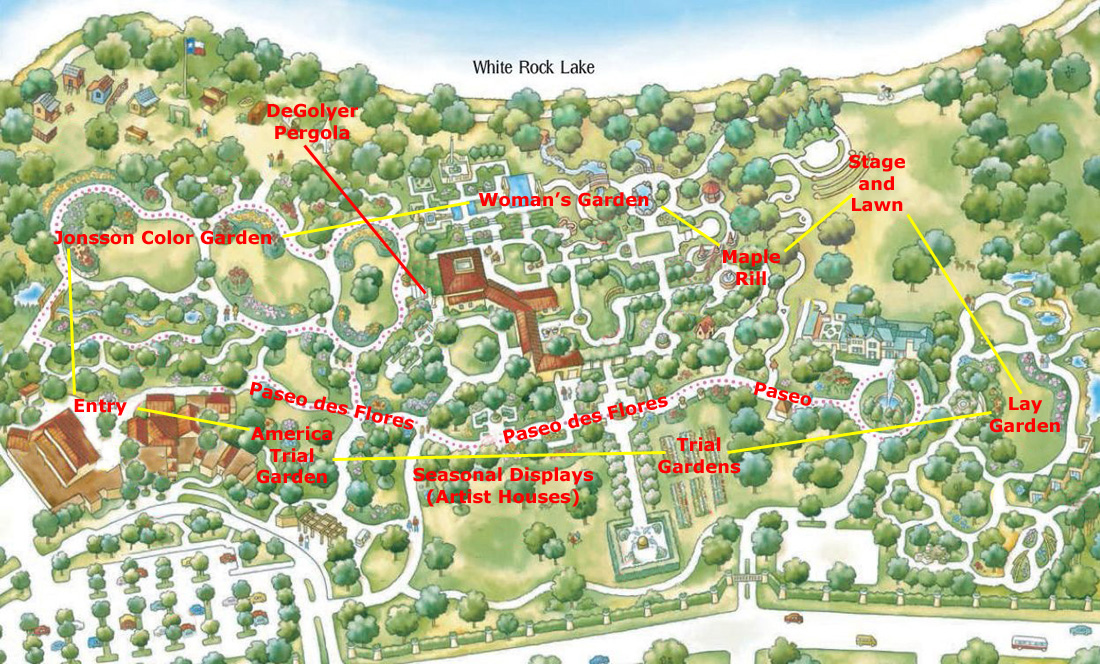
|
I'll divide up today's pictures by garden, and with each group you'll find a little inset map with our current location marked and the Chihuly installation(s) we found there also marked. Some of the installations, such as "Garden Grass," have multiple iterations and can be found in multiple locations. I will try to mark as many of them as I can. So let's head off from the parking area into the Arboretum to have a look at both the glass installations and the gardens themselves.
Cissy Thomsen Welcoming Water Wall
We came across the first installation even before we had entered the Arboretum.
Installation Name: Blue Icicles
Beside the stairway down to the entrance from the parking area, there is a small waterfall, although I never knew it had a name. That was where we found the first installation, as shown on the diagram below:
In 1996, Chihuly developed an element for his Icicle Creek Chandelier that he hoped could withstand the snowy winters and hot summers of Central Washington state. The resulting icicle form, both beautiful and sturdy, has become a favorite of the artist in a number of outdoor installations since then. One icicle part in your hand is remarkably heavy. Wherever they are placed outdoors, and no matter what the color, the add a startling visual punch. Here at the Arboretum, clear, turquoise and cobalt icicles reflect the Texas sunlight in dramatic fashion.
Ginsburg Plaza
We crossed the driveway, went through the Member's entrance and came into the Arboretum proper. The entry point here at the Arboretum is the Ginsburg Plaza, which is situated between the restaurant, gift shop and educational center.
We noticed one big difference from the last time we were here at the end of August- the pumpkins and gourds have arrived. Every fall, right up through Thanksgiving, there is a huge display of pumpkins and gourds, and many of the display houses shift over to using them as decoration. When we arrived, we found
pumpkins lining the plaza.
The Palmer Fern Dell
Following our usual, generally circular route through the gardens, we went around the west side of Ginsburg Plaza, down some steps and arrived at the west end of the fern dell.
The Eugenia Leftwich Palmer Fern Dell, designed by Naud Burnett, is an enchanting mini-garden located within the Jonsson Color Garden. More than 90 varieties of ferns, camellias, witch hazel, azaleas and mature trees border a meandering brook. The Palmer Fern Dell is a welcome oasis during the summer months as a micro-fine mist system regularly envelops the garden.
Here, we found the first of many installations of a genre that Chihuly calls, simply, "Garden Glass." These were tall, slender grass-like shapes, sometimes straight and sometimes with curliques at the top. The color seemed to complement the place in the garden where they were located. Usually, they had different names.
Installation Name: Blue Marlins and Turquoise Reeds
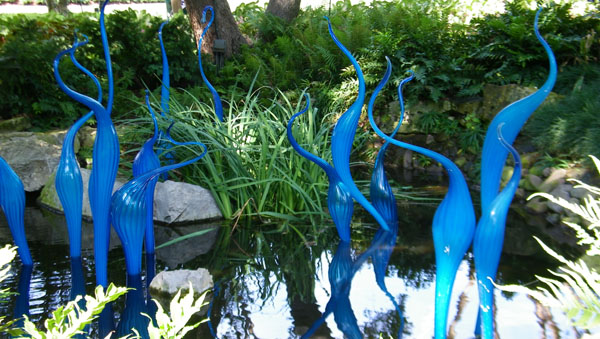
"Blue Marlins"
|
|
Garden Glass reflects the artist's affinity for plant-like forms. "There's something about the fluidity of glass that makes it want to make forms from nature", Chihuly said. "My forms are made in a very natural way, using fire, gravity, and centrifugal force, so they look like they come from nature. But I don't look at pictures of plants and say now I'm going to make one that looks like that."
In addition to the Blue Marlins seen at right, the fern dell also contained three sets of the
Turquoise Reeds.
Chihuly made the first Reeds at the Hackman factory in Nuutajarvi, a small glassblowing town in Finland. Unlike other factories, the Hackman facility has very high ceilings, which inspired Chihuly to make these elongated forms. To create the long tubular shape of a Reed, one glassblower must be elevated in a mechanical lift while blowing through the pipe to encourage the form to stretch, while another pulls the glass toward the ground. As Chihuly said, "In Finland we started making these long, cylindrical pieces which loojked like spears. This was an exciting new form. It was the first time we ever made anything like that. They can be taken anywhere; they can go outside. They are very strong pieces, and they are very dramatic."
Both the different installations were very pretty, and their deep blue color suited the deep shade of the fern dell.
Fred and I took some other good pictures here in the Fern Dell, and you can use the clickable thumbnails below to view some of them:
The Jonsson Color Garden
The next installations were in the large Jonsson Color Garden north of the Fern Dell.
The Jonsson Color Garden is a broad, lawn in three ovals, and each oval is surrounded by interlocking walkways. The are shaped flower beds at various locations along the outside of the ovals; these are always planted with colorful flowers of the season, and on the north side of the garden are a wide variety of azaleas. The center of the lawns is pretty much open, and is a great place for picnics or for families with kids.
Here, we found a number of different Chihuly glass installations.
Installation Name: Yellow Icicle Tower
The Yellow Icicle Tower
shoots up 30 feet and is a perfect example of Chihuly's desire to mass color for dramatic effect. The combined elements create what Chihuly once described as "a core of color." Among the things for which Chihuly is most known are his monumental blown glass sculptures like this one. It is even dramatic
from some distance away.
Installation Name: Cattails and Silvered Red Bamboo
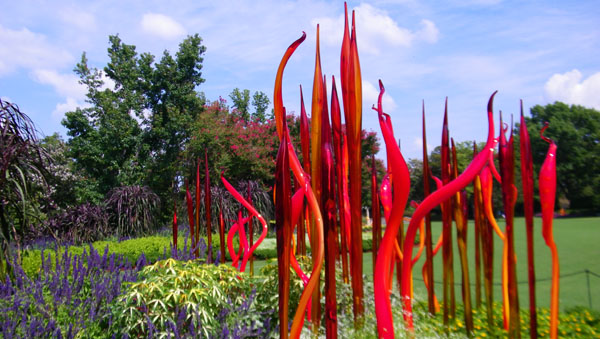
"Cattails" and "Silvered Red Bamboo"
|
|
This installation was a combination of two forms- the tall, slender, straight cattail form, and the more plant-like bamboo. There are clickable thumbnails below that you can use to see some additional pictures of this installation:
A Woman's Garden
The next few installations were in a relatively new area of the Arboretum- the large Woman's Garden that has been created in the area between the DeGolyer House and White Rock Lake.
This 1.8-acre formal garden, which opened to national acclaim in 1997, was a gift to the Arboretum by its Women's Council. Designed by landscape architect Morgan Wheelock, it is comprised of several small garden "rooms". The dramatic focal point is a reflecting pool that provides a water-on-water view overlooking tranquil White Rock Lake.
The main entrance to the garden is through the portal at the northeast end of the Jonsson Color Garden; this brings the visitor to the top of a stairstepped water feature that leads down into the garden. Small channels of water surround the plain grass center of the area. Steps lead up from this garden to the DeGolyer House.
Going through the portal into the Woman's garden, we found ourselves at
the upper fountain
at the beginning of the stairstepped water feature leading downwards.
Installation Name: Neodymium Reeds
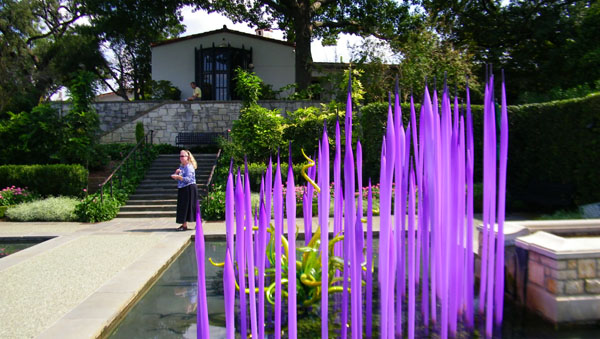
"Neodymium Reeds"
|
|
As soon as we entered the Woman's Garden through the asymmetrical towers, could see the stairstepped water feature ahead of us, and we could look down into the Woman's Garden. We descended the steps along the water feature, and, at the bottom found
It was at the base of the water feature that we found
the Neodymium Reeds.
Chihuly made the first Reeds in Finland, and these are the same tall, thin sculptures that we would find throughout the garden, in different colors to complement their location. These long, cylindrical pieces look like spears stuck in the ground, and Chihuly is fond of using them in outdoor installations both for their durability and their dramatic effect. These reeds have another, different sculpture at their base (a piece that was unnamed).
Installation Name: Mirrored Hornets
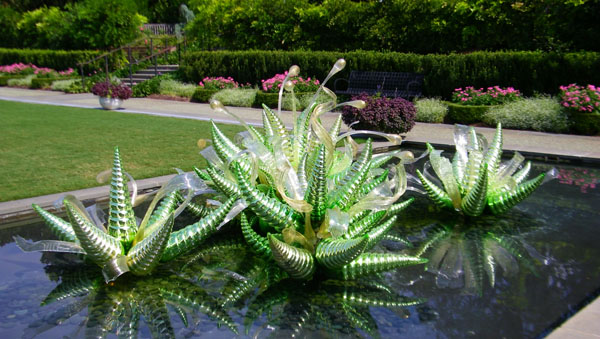
"Mirrored Hornets"
|
|
The Woman's Garden has its stairstepped water feature at the western end; going east through the garden there is next a walkway that leads across the garden north to south that leads from the steps down from the DeGolyer home and across to the balcony overlooking the Poetry Garden. Next, there is a rectangular pool, and it was this pool that was the site of the installation of the Mirrored Hornets. Beyond that is a long, rectangular flat lawn bounded by a one-foot-wide moat, followed by another cross-garden walkway and then, finally, the infinity pool we will get to in a moment.
For the Mirrored Hornets, molten glass is blown into a spiral mold to make the Hornet form. The glassblower must literally unscrew the hot glass to remove the form from the mold.
While Fred was with Prudence photographing the Hornets, I went up on the patio of the DeGolyer Home.
|
(Mouseover Image if Video Controls Not Visible) |
I had not brought my little camera; since this was the third time we'd been here, I didn't think I'd find much new. But I did have my iPhone, so I took it out to take a couple of pictures. I took three from this vantage point looking down into the Woman's Garden, and there are clickable thumbnails for them below:
And while I was at it, I thought I would try taking a movie with my phone; I don't recall having done that before. It worked, taking the same kind of widescreen movies that Fred's camera does. When I converted it for this web page, it seemed a little jittery; I will have to investigate why that happens. But it is perfectly watchable, and you can do so with the player at right.
Installation Names: Float Boat and Carnival Boat
The next two installations were both in the infinity pool at the east end of the Woman's Garden, and they were both strikingly beautiful.
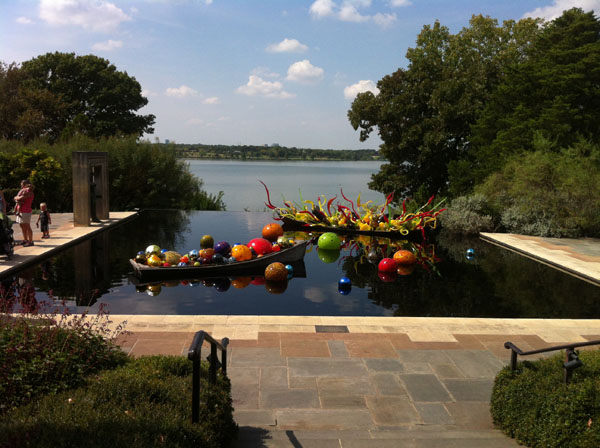
"Float Boat" and "Carnival Boat" |
|
Chihuly first filled boats with his glass elements in Nuutajarvi, Finland during the Chihuly Over Venice project in June 1995. After several days of glass blowing in the hotshop, the team made temporary installations along the Nuutakoki, the river nearby. For the Carnival Boat, Chihuly filled a boat with the same parts that are used in his Chandelier series. For the Float Boat, he simply filled a boat with the same sculptures that he floated in water or simply laid in gardens. We saw these same floats in St. Louis in the central pool of the Botanical Garden there. Chihuly made most of these parts and floats (and many other glass forms) during the Finland trip.
As I said, these installations, and the individual floats around them, were quite beautiful; the combination of the colorful sculptures and the blue water of the infinity pool plus the backdrop of White Rock Lake made for
an entrancing scene.
We prevailed on another garden visitor to take our picture with the two boats in the background. After a few tries, we got one we liked, and you can see it
here.
.
|
(Mouseover Image if Video Controls Not Visible) |
As we left the Woman's Garden through the portal at its east end, heading towards The Grotto, I made another movie, and you can watch it with the player at right.
The Grotto
From the Woman's Garden, we walked along the
shaded pathway
to The Grotto. is a small, shaded garden with a water feature; it is located at the foot of the Red Maple Rill, between the Rill and White Rock Lake. It is a secluded garden, with a number of benches beside the water feature, and is a great place to sit and relax.
Installation Name: Persian Pond
The next installation we came to was in the pool that is part of the rock-lined water feature in The Grotto.
Chihuly began his Persians series in 1986 as a search for new forms, always for Chihuly being a vehicle for color. Early works in the series were oddly shaped and intensely colored but were soon transformed. As Chihuly continued to expand and modify his Persians, he began to see their potential for large, dramatic installations.
Fred took a few pictures of the Persian Pond, including the lily pads floating in it (which were blooming). Use the clickable thumbnails below to have a look:
I made a movie here at the Grotto, and you can watch it with the player below, left.
|
(Mouseover Image if Video Controls Not Visible) |
Fred also got a nice picture of Nancy and Prudence; you can see it below:
The Red Maple Rill
The Nancy Rutchik Red Maple Rill is one of the Arboretum's newest gardens.
The Red Maple Rill, which opened on October 6, 2011, has a much different beauty than the areas where colorful plants are found. With its gentle slope and shaded artificial stream, it's almost as if you aren't in Dallas anymore, but in the mountains somewhere. The main design elements include a new entry off the Paseo de Flores, plus a large gathering plaza. A meandering creek with numerous waterfalls flows down the hillside, ending in a large pond. About halfway down the hill a stone bridge crosses the stream, connecting the paved walkways around the Rill with the Martin Rutchik Concert Lawn and the Magnolia Allee. At the crossing there is a small plaza, which is a great place to sit and enjoy the beauty of the Rill.
“The most impressive feature is a fabulous collection of over 80 varieties of 200 Japanese Maples,” commented Dave Forehand, Vice President of Gardens. “Two hundred trees are planted up and down the stream with an understory planting beneath the canopy. An especially large weeping Japanese maple nearly 100 years in age anchors the center of this new garden area.”
The Red Maple Rill increases the Dallas Arboretum’s collection of Acer species and cultivars to over 120 varieties. Not only is this garden a beautiful serene oasis along the Paseo, but is also a horticulturally important garden with an impressive collection of Maple species and cultivars.
Installation Name: Sun
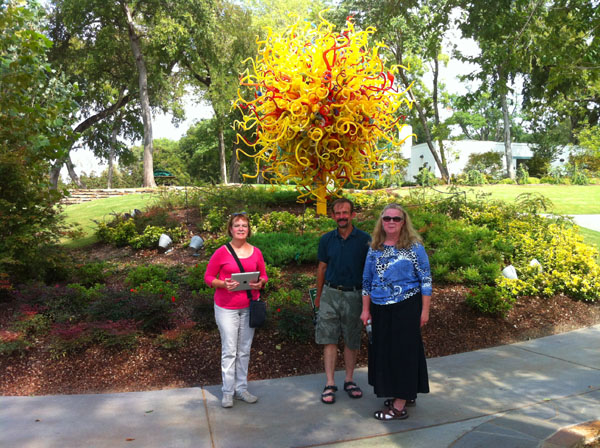
"Sun"
|
|
Chihuly's Sun is a radiant, 14-foot diameter globe of red, orange and yellow glass branches curling outward from its center. Massed together, the hundreds of twisting glass elements create a powerful effect. Chihuly has said, "No other material gives you color like glass does. No othe rmaterial has the ability to take in light and radiate out color like glass."
The installation sits at the edge of the Martin Rutchik Concert Lawn, just on the lawn side of the bridge that crosses the Rill. It does indeed look like a small sun that has descended to touch the earth.
Installation Name: Citron Green and Red Tower
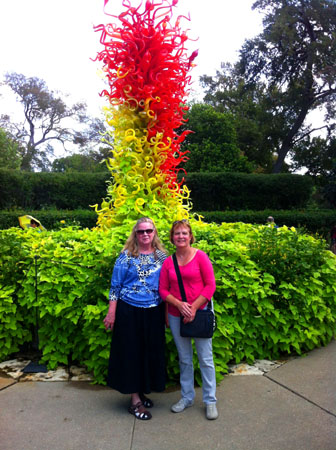
"Citron Green and Red Tower"
|
|
Chihuly's Towers evolved from his Chandeliers. In 1992 he began massing blown glass forms on steel armatures to create large, hanging sculptures.
Subsequent projects challenged Chihuly to create large sculptures in spaces where the ceilings could not bear the weight of his Chandeliers or where there were no ceilings at all. This gave life to the development of his Towers.
The two contrasting colors of the Citron Green and Red Tower provide an additional playful pop of color among the vivid Dallas Arboretum blooms.
Paseo de Flores
From the Red Maple Rill, we came back out onto the main walkway through the center of the Arboretum- the Paseo de Flores. Walking back west towards the Ginsburg Plaza, we made a number of stops along the way, not only for Chihuly installations but for the artist houses and the pumpkin patch.
The Lyda Bunker Hunt Paseo de Flores, known simply as the Paseo, is the central walkway of the Dallas Arboretum. This meandering pathway, designed by Luis Santana, runs from the Trammell Crow Visitor Education Pavilion to the Alex Camp House and the entrance to the Lay Ornamental Garden.
Artist House: Pablo Picasso
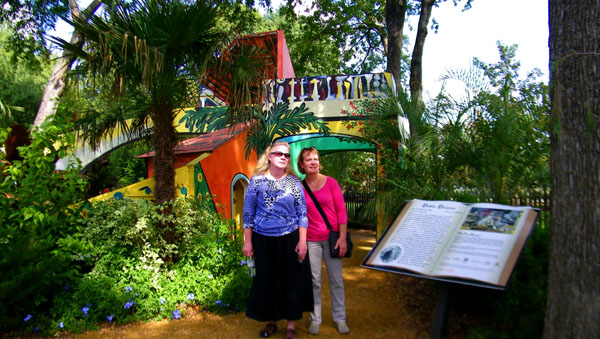
At the Pablo Picasso House |
|
For some time, the Arboretum has had a semi-permanent exhibit of "Artist Houses." These houses, located south of Paseo de Flores, are small structures that visitors (and especially kids) can walk through and look at. Each one is of an architectural style and sports decorative elements that evoke the particular artist for which the house is named. The four honored artists are Pablo Picasso, Georges Seurat, Vincent van Gogh and Georgia O'Keefe.
Today, we stopped in at two of these, the first being the Picasso house. It is colorfully and abstractly decorated, even with
simulated Picasso paintings,
and is probably my favorite of the houses. Below are clickable thumbnails for two additional pictures we took at the Picasso House:
Artist House: Georges Seurat
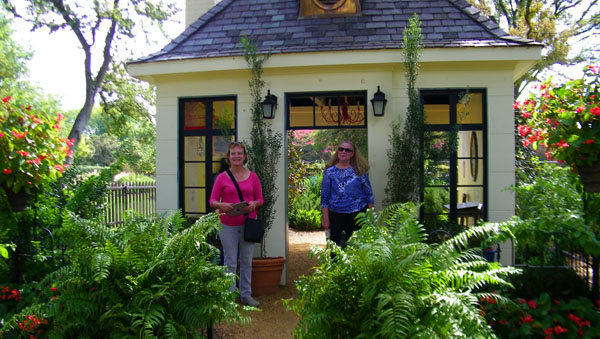
At the Georges Seurat House |
|
The Georges Seurat house looks like a small French Provincial chateau, as befits the background of the artist most famous for "Sunday in the Park with Georges".
We took a couple of pictures inside the house. Fred took one of
me by the fireplace,
and I captured one of
Fred and Prudence sitting at the table.
Installation Name: Ruby Fiddleheads
Going west along the Paseo, the next installation we came to was the Ruby Fiddleheads.
The Fiddleheads were another example of Chihuly's Garden Glass series, which reflects the artist's affinity for plant-like forms. "There's something about the fluidity of glass that makes it want to make forms from nature", Chihuly said. "My forms are made in a very natural way, using fire, gravity, and centrifugal force, so they look like they come from nature. But I don't look at pictures of plants and say now I'm going to make one that looks like that."
Installation Name: Dallas Star
If there was ever a sculpture with a dramatic burst of energy, this may be it. The artist repeats one icicle shape hundreds of times to visually explode this sphere. The movement is in the color: the energy of the deep cobalt blue of the core is quickly released by the clear glass of the outer sphere.
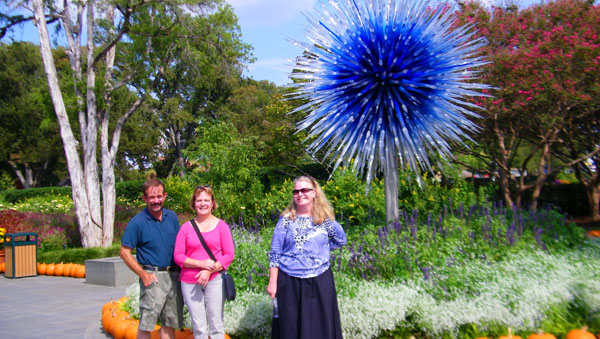
"Dallas Star" |
|
The Dallas Star was certainly an energetic piece, and while energy is a characteristic found in all of Chihuly's artwork, this installation exemplified it perhaps better than any other. When asked about the way he works, Chihuly answered, "Quick and immediate and spontaneous, with an element of chance." And asked about where ideas come from he said: "The only explanation I'm ever able to give about where things come from is 'energy.' That has to come out in one way or another. Sometimes it's more destructive, sometimes it's more beautiful, sometimes more creative. Energy can go in so many directions, and you have to harness it. Correction! Youy don't harness it, you use it. You put it to good use."
This was such a pretty piece that I've put clickable thumbnails below for two more pictures of it:
| Installation Names: |
Green and White Striped Reeds
Black and White Striped Reeds |
|
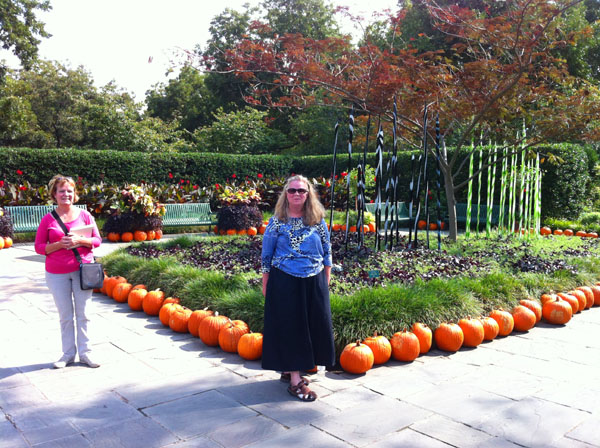
"Black and White Striped Reeds"
"Green and White Striped Reeds" |
|
This was the final installation of Chihuly's Reeds that we encountered in the Arboretum (and, as a matter of fact, the last Chihuly installation we visited). The tall, slender glass spears could only have been made in a glassblowing factor with high ceilings- like the Hackman factory in Finland, where Chihuly first made them. As Chihuly said, "This was an exciting new form. They can be taken anywhere; they can go outside. They are very strong pieces, and they are very dramatic."
But then we thought that all of Chihuly's pieces were dramatic.
Along the Paseo de Flores
During the Fall, the Paseo de Flores is outlined in a multitude of pumpkins and
gourds;
I have no idea how many must be brought in each season.
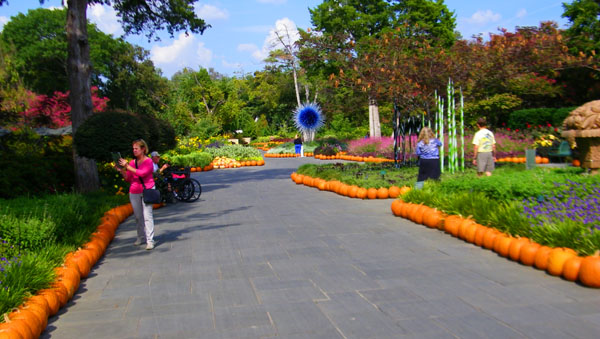
Part of the Paseo de Flores |
|
It makes for a very pleasant walk, and offers lots of picture opportunities. There are clickable thumbnails below for some of the pictures we took with Prudence and Nancy along the Paseo de Flores:
Pumpkin Village
Pumpkin Village is a yearly tradition at the Arboretum. A large area just south of the Paseo de Flores is given over to a group of houses constructed mostly with pumpkins and a huge pumpkin patch that not only offers wonderful picture-taking possibilities, but offers pumpkins for sale as well.
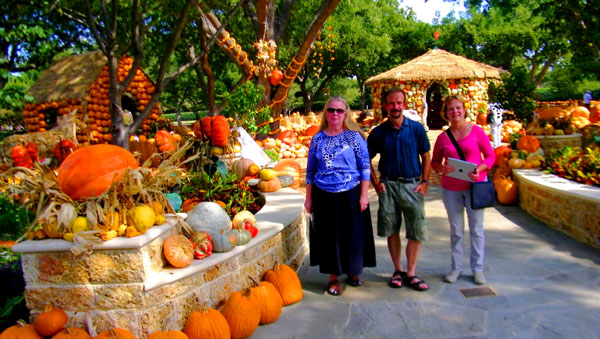
At Pumpkin Village |
|
Pumpkin Village is always a treat to walk through at this time of year; the summer heat has usually broken and while Fall might not yet be in the air, it certainly seems so with all the Thanksgiving-oriented pumpkins scattered and piled about.
Below are clickable thumbnails for some of the pictures Fred took here:
We spent a fair amount of time just walking around Pumpkin Village, and Prudence was snapping away with her iPad.
|
(Mouseover Image if Video Controls Not Visible) |
I made a movie here in Pumpkin Village, and you can watch it with the player at right. (The reason the movies on this page are a little jittery is that my iPhone camera does not have true image stabilization like my little camera does.)
I also took some pictures here in Pumpkin Village, and there are clickable thumbnails below that you can use to have a look at them:
This was a really nice afternoon at the Arboretum, and we think that Prudence and Nancy really enjoyed it.
You can use the links below to continue to another photo album page.
 |
October 1, 2012: Chihuly at Night |
 |
September 18, 2012: Summer's End at Downhill Run Acres |
 |
Return to the Index for 2012 |






